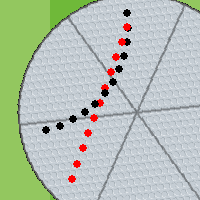| |
Hands-On, Minds-On Meteorology
Description
| Programming | Operation
| Coriolis
(including
large-sized version)
Description
The Coriolis program is designed to replicate the merry-go-round animation
found on the WW2010
website, but to provide an interactive platform for students to
investigate. The program shows a rotating disc that has the capability
to spin in both directions The action can be viewed from outside the
rotational frame of reference, or from within the rotational frame of
reference. A larger version for use in lecture halls is also available.
|

click for whole shot |
Objectives
The primary objective of the Coriolis program is to provide students
the means by which to discover how and why the Coriolis effect works.
Programming
Theory
The program begins with the ball at the edge of a stopped disc. Once
the student begins to spin the disc, he or she can release the ball
towards the middle. If you are looking at the disc from above, you
are not rotating along with it, the ball has not only the original
radial (towards the center) velocity, but it also has the rotational
velocity of the disc. The ball will travel straight along the path
that sums these two velocity components, while the disc is rotating
underneath. In the Above Disc case, two paths are drawn, the red path
illustrates the ball as it moves, and is always straight. The black
path represents where the ball was on the disc at the time it passed,
like there was black paint on the ball marking its path on the disc.
This path will always be curved unless the disc's rotation is 0. In
the On Disc case, only a black path, showing the balls movement is
drawn.
Assumptions
The ball is always initially thrown towards the center of the disc
with respect to the release point.
Equations
Note that no equation for Coriolis force is actually used to display
any of the paths. An earlier version of the program did use Coriolis
force equations to determine the path in the On Disc case, but two
many assumptions are made in the equations that cause increasing error
with respect to the Above Disc case. The paths grew increasingly different
as rotation speeds increased so they had to be removed. Instead the
black path from the Above Disc. case is simply drawn without rotating
it. Deflection measurements are calculated by determining how far
the ball is from the centerline axis (seen most easily in On Disc.
mode).
Other
Any other information
Operation
Running the Program
- Click the link for Coriolis or Coriolis (Large).
- Initial Radial Speed changes the speed the ball is initially released
at.
- Rotation (rpm) changes the rate at which the disc rotates. A negative
rotation rate causes the disc to rotate counterclockwise -- or in
the opposite direction when the rotation (rpm) is positive.
- Once the desired values are set, start the disc by clicking the
Start button.
- When ready, release the ball by clicking the Release button.
- Press the Stop button to stop the disc.
- At any time, change the viewing perspective by clicking the appropriate
radio buttons.
- Pressing Start again resets the experiment and deletes existing
data.
Extra Knowledge
N/A
 |
Department of Atmospheric Sciences
University of Illinois at Urbana Champaign
Created by Dan Bramer: Last Modified 07/27/2004
send questions/comments to bramer@atmos.uiuc.edu
|
|







